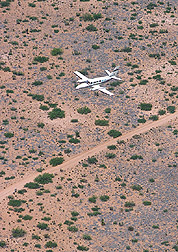This page has been archived and is being provided for reference purposes only. The page is no longer being updated, and therefore, links on the page may be invalid.
|
Read the magazine story to find out more. |
The Flying CameraBy Don ComisSeptember 10, 2001 As the only Agricultural Research Service pilot in the country collecting remote-sensing imagery, Michael Rene Davis has learned the secret to accomplishing complex scientific missions: keep it simple. He has honed this philosophy to a science with more than 6,000 hours in the sky. His answer to keeping the sun directly behind him for light-reflectance imagery: mount a 3-inch bolt on the fuselage as a sundial to let the sun's shadow point the way. Just flying the plane is enough to think about without being distracted by analyzing sun angle tables. Davis is in his 31st year of flying for ARS, accident-free. He flies out of the ARS Kika de la Garza Subtropical Agricultural Research Center in Weslaco, Texas. He has flown missions in 21 states. Next month, he will fly his "camera with wings" over the Chihuahuan Desert, piloting a fully loaded 10-passenger, twin-engine Cessna 404 Titan. The plane was a gift from the U.S. Customs Service, which confiscated it from drug dealers. It has three cameras mounted through its belly. For less demanding assignments, Davis flies a six-passenger Cessna 206, another "donation." He flies scientists over the Chihuahuan Desert twice a year, to help them collect imagery to study interactions between landscapes and climate. Davis spends up to three hours in 100-degree heat as he flies at 300 feet above the desert floor. It's so hot and bumpy that many camera operators literally can't stomach it. His job requires not only a cast-iron stomach but also a researcher's curiosity. He has taken college courses in plant sciences and other topics to help him interpret the imagery on the television monitor he uses to stay on target. His job tests his mechanical, electrical and photographic skills as well. For more details about Davis' previous flight over the Chihuahuan, see Agricultural Research magazine. ARS is the U.S. Department of Agriculture's chief scientific research agency. |

